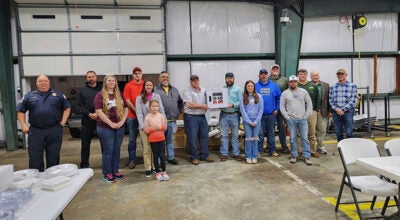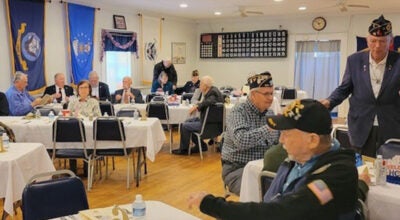COVID-19 response is community-supported effort
Published 4:20 pm Monday, June 29, 2020
|
Getting your Trinity Audio player ready...
|
By Nate Delesline III
The Smithfield Times
Managing Western Tidewater’s response to the coronavirus is an all-hands-on-deck effort.
Dr. Todd Wagner and Will Drewery of the Virginia Department of Health are steering the state’s local response. Wagner is director of the Western Tidewater Health District. Drewery is the district’s emergency manager.
However, they are quick to credit members of the state health department’s Medical Reserve Corps. The volunteer group supports the department by providing staffing support for medical services, outreach, education and investigations.
Medical Reserve Corps members were essential to operating two recent testing sites — Smithfield on June 22 and Windsor on June 25. The free COVID-19 screenings were facilitated by the health district in partnership with Isle of Wight County and the towns of Smithfield and Windsor.
According to Wagner and Drewery, 121 people were tested in Smithfield on June 22, and 105 were tested in Windsor on June 24. They were the most recent of several testing blitzes conducted in Isle of Wight County, Southampton County, Suffolk and Franklin, which comprise the health district.
“We’re a small but mighty health district and if we didn’t have these guys, it’d really be challenging,” Wagner said. “They’re always out here, they’re always helping out — Monday, Tuesday, weekends — whatever we’ve asked for them, they’ve responded.”
Drewery echoed that sentiment.
“We’ve got RNs, we’ve got doctors, LPNs, CNA, I think we’ve got a few morticians, EMTs, paramedics,” Drewery said. Other volunteers don’t have professional health care experience but are willing workers who want to help their community and do so by providing help with logistical and administrative tasks.
Robin Jones was among the corps volunteers at the Windsor event. How’d she get involved?
“My mom donated her body — she was an anatomical donation. And my husband and I decided we were going to do it,” Jones said. They went online and ran across a link for the Medical Reserve Corps.
Jones has about 40 years of health care experience in roles such as nursing instructor, OB/GYN nurse practitioner and certified nurse midwife. She also recently became an EMT with the Isle of Wight Volunteer Rescue Squad and had done contact tracing work.
John Quidley is a Corps volunteer and a rising senior at Old Dominion University who is studying biomedical sciences. He decided to get involved after the school sent an email asking for volunteers.
“My experience with this so far has been great,” Quidley said. “Our coordinators are wonderful, most of the patients we see are fairly nice, and it’s just rewarding to help the community in such a time of uncertainty.”
Looking ahead, Quidley said he’d like to pursue a doctoral degree and work as a virologist.
The Corps serves as a secondary workforce providing an extra layer of continuity. “I would say they’re integrated into our system,” said Wagner.
My experience getting tested
As Jones left our shady spot to help register someone, Wagner approached me again.
“If you’re interested, we’ll get you checked in here and they’ll walk you down. It’s really not a big deal,” he said.
I paused. My mind flashed back to social media videos I’ve seen of people wincing in pain, gagging, coughing and sneezing upon receiving the swab. Then my mind drifted to B-roll TV news footage of the pixelated faces of people attached to ventilators unable to breathe.
I decided that ignorance was not bliss, and a few moments of potential discomfort was preferable to a hospital admission or unknowingly harming my family or friends. I decided to get tested.
Johnson returned and took down some basic personal information, then directed me to a tent where several people in full personal protective equipment were waiting.
As I approached, a woman in a Jeep who had just been tested smiled, waved at the testing crew, rolled up her window and drove away. She’s probably stronger than I am, I thought.
“Good morning,” called one of the women, waving me over. She asked me to state my full name and birthdate, then handed my form to another person at a table.
“Step into the shade,” said the first woman. The sharp crackle of the swab being removed from sterile packaging seemed unexpectedly jarring — somehow louder than the diesel rumble of the county’s mass casualty incident vehicle, which was made available as a place for staff and volunteers to take a break out of the heat.
I noticed a chair behind me, “Perhaps I should sit down?” I asked. The woman holding the swab shook her head. “It won’t be that bad. We’re going to do both nostrils. Ten seconds.”
As the swab disappeared from my peripheral vision, I prepared for pain.
Instead, I felt a deep tickle in the back of my nose and throat. An unfamiliar sensation, but not painful at all. Yet, even in the middle of it, I wasn’t convinced. Surely the tickle must be the prelude to something worse.
But before I knew it, the test was over. I felt a strong, brief urge to sneeze. That’s it.
Results are returned in about four business days — anyone testing positive gets a phone call.
As the state’s phased reopening continues, Wagner urged the community to proceed with caution and common sense.
Reopening, he said, “doesn’t mean the disease has gone away. … People just need to be cognizant of the fact that there are still cases out there, there are still being deaths reported. I want to take the opportunity to make sure people are continuing to be engaged and we’re doing our best to help support the cause of not spreading the disease further.”




